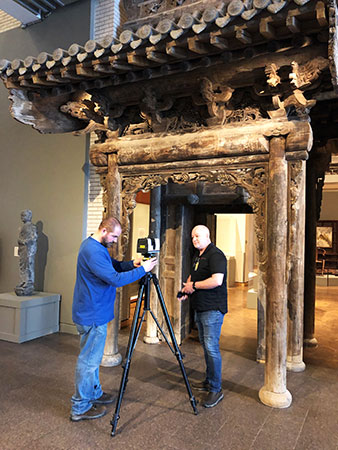3D Scanner Excels at Long Ranges for Half Cost
As published in New Equipment Digest | By John Hitch
View original article here
Artec 3D has made a name for itself as the premier manufacturer for high performance, affordably priced handheld 3D scanners. They may not always be the most powerful, but Artec’s understanding of what users want and need—a balance of simplicity and professional quality— puts the Luxembourg-based company in the same lofty stratosphere as Apple. And come to think of it, the Artec Leo does look like it could be related to an iPhone.
When dealing with the precise world of metrology, not everything, especially at longer ranges, can be scanned by hand, though. Like with conventional cameras, the farther out you get, the less detail you capture. And you don’t want the car you are digitizing to come out looking like a Michael Bay’s version of a Transformer, all shaky and lacking character or depth. And what if you need to scan a giant wind turbine or the interior of a factory for some new virtual training application?
That would take forever by hand, and forever isn’t a reasonable time table in the fast-paced manufacturing environment. Last year Artec released a solution, called the Ray, that retains the company’s lauded ease of use and transfers it over to large objects. Typically placed on a tripod, the compact, 11-lb. scanner uses LIDAR for submillimeter accuracy while maintaining a scanning range of 110 meters, the length of a fast-attack submarine. The ranging error in the “high quality mode” at 15-m spans is 0.7 mm, while about 5 mm at 110 meters when set to high sensitivity.

Artec Ray
With the press of a button, the device, which has 360-deg horizontal and 270-deg vertical field-of-view, begins capturing at a speed of 208,000 points/sec. The associated software, Artec Studio 13, employs high-powered algorithms to speed up editing and post-processing of larger objects.
For Sean Rittenhouse, a sales engineer specializing in Artec gear for CyberOptics’ Laser Design scanning service, the Ray, which costs $60,000, fills a much-needed niche in his role that could have him scanning an airplane one day and the interior of a factory the next.
“It has a higher accuracy than any other long-range system for certain applications, it’s half the cost of very good systems, and has a light, compact form factor that makes it easy to travel with,” says Rittenhouse, whose bureau has done more than 40,000 successful scan jobs.
Rittenhouse adds that those more expensive scanners exceed the Ray’s range, though he seldom needs more than 110 meters. Among the jobs he has completed with the Ray include scanning an airplane with a 36-meter wingspan for computational fluid dynamics studies and digitizing the interior of an Ohio manufacturer for a virtual reality company to use in trainings and simulations.
Along with those future-forward applications, the Ray helps preserve the world’s architectural history, presumably for when we all enter the Matrix. Recently, Rittenhouse traveled to the Minneapolis Institute of Art to digitize its recently acquired Qing gate, a 161-year-old ornate wooden gate once affixed to the exterior of a wealthy Chinese family’s compound. At 4.5-m high, it fell well within the optimal threshold for maximum accuracy, so every intricately carved grape lining the door frame could be recorded for posterity. It stands to reason that because of its price point, the Ray could help save many more architectural antiquities before they get torn down for modern buildings or decayed by time.

Laser Design Tech Jeff Trei (left) and Sales Engineer Sean Rittenhouse (right) capture scans of a 161-year-old Chinese gate.
That’s nice for history’s sake, but its availability creates a domino effect on manufacturing. The more affordable it is, the more companies, be it a smaller service bureau or manufacturer, can take advantage of long-range scanning to create realistic training simulations of actual work scenarios, or for immersive design as Dassault Systèmes does with HTC Vive VR headsets on its 3DEXPERIENCE platform. These sound like uses that are several years out, but the affordable tech puts these closer within reach.
“[Smaller companies] have a tough time swallowing $130,000 in equipment costs as opposed to $60,000,” Rittenhouse says.
The number of applications, from reverse engineering to quality control to product design, go on and on, but the actual training to use the ray does not. This could take two to four hours and be done online via webinars or video conferencing, Rittenhouse has found through his reselling duties.
“Almost anyone off the street can use it,” Rittenhouse says. This includes mom and pop shops of all kinds, such as a mall kiosk business that scan engaged couples to create 3D-printed wedding cake toppers.
That’s certainly a niche use, though it can be used for the most critical manufacturing applications, such as verifying quality. Rittenhouse has put the Ray inside of an engine to capture 360-deg of data of its interior, as the machine can be activated via WiFi. Scans can also be done autonomously via lifts and mobile robots.
“There are tons of possibilities for the Ray in more advanced robotics applications,” Rittenhouse says.
